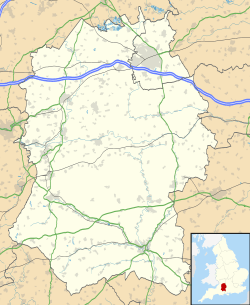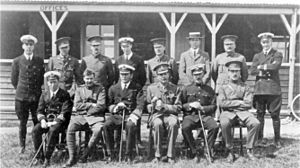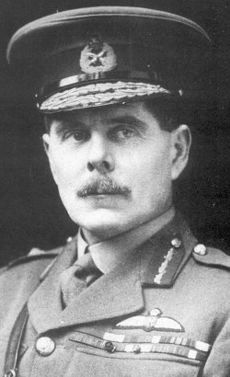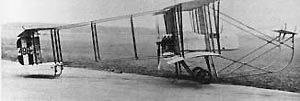RAF Upavon facts for kids
Quick facts for kids RAF Upavon
|
|||||||||||
|---|---|---|---|---|---|---|---|---|---|---|---|
| Near Upavon, Wiltshire in England | |||||||||||
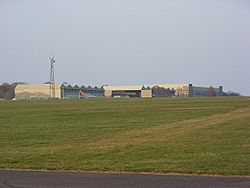
The airfield at former RAF Upavon, 2007
|
|||||||||||
|
Location in Wiltshire
|
|||||||||||
| Coordinates | 51°17′26″N 001°46′42″W / 51.29056°N 1.77833°W | ||||||||||
| Type | Royal Air Force station | ||||||||||
| Site information | |||||||||||
| Owner | Ministry of Defence | ||||||||||
| Operator | Royal Flying Corps (1914–1918) Royal Air Force (1918–1993) |
||||||||||
| Condition | Closed | ||||||||||
| Site history | |||||||||||
| Built | 1912 | ||||||||||
| In use | 1912–1993 | ||||||||||
| Fate | Transferred to the British Army and became Trenchard Lines. | ||||||||||
| Airfield information | |||||||||||
| Identifiers | IATA: UPV, ICAO: EGDJ, WMO: 03744 | ||||||||||
| Elevation | 175 metres (574 ft) AMSL | ||||||||||
|
|||||||||||
Royal Air Force Upavon, or RAF Upavon, was a special place in Wiltshire, England. It was a base for the Royal Air Force (RAF). Imagine a big grassy field where planes took off and landed! It was also a school for pilots and a main office for the RAF. This important station opened in 1912. It closed in 1993 and was given to the British Army. Today, it's known as Trenchard Lines.
The motto for RAF Upavon was In Principio Et Semper. This is Latin and means "In the Beginning and Always".
Contents
The Story of RAF Upavon
How It All Began
Building work for RAF Upavon started on June 19, 1912. It was built on high ground near the village of Upavon. This area is close to the famous Salisbury Plain in Wiltshire. The airfield was first made for pilots from the new Royal Flying Corps (RFC). This group included both army and navy pilots.
Upavon became home to the Army Central Flying School. This was a special school for teaching pilots. Captain Godfrey M Paine was the first leader. His helper was Major Hugh Trenchard. Trenchard later became a very important leader in the RAF. People called him the "father of the Royal Air Force".
Amazing Early Flights
In 1913, something amazing happened at Upavon. Lieutenant Cholmondeley made the first ever night landing in England here! In May 1914, Winston Churchill visited Upavon. He was a very important government official at the time. He even took a flight in a Farman biplane!
Between 1914 and 1915, two officers at Upavon created something new. They developed a special device called a bomb sight. This device helped pilots aim bombs better. It was used with great success during World War I. On March 21, 1917, the first unmanned target aircraft were tested here. About 30-40 allied generals watched this important test. The main building for officers, called the officers' mess, was finished in 1915. It is now a very old and important building.
The Birth of the RAF
A big change happened on April 1, 1918. The Royal Flying Corps (RFC) joined with the Royal Naval Air Service. Together, they created the Royal Air Force (RAF)! Because of this, Upavon became Royal Air Force Station Upavon. The Central Flying School also became part of the new RAF.
In 1926, the Central Flying School moved away from Upavon. But other squadrons moved in! No.17 (Fighter) Squadron RAF joined No.3 (Fighter) Squadron RAF at Upavon. For the next eight years, these fighter squadrons worked hard. They improved night flying and air fighting skills. They also put on amazing air shows for people all over the country! In May 1934, both squadrons left Upavon. They were replaced for a short time in 1935 by four squadrons from the Fleet Air Arm.
The Mystery of the St. Raphael
On August 31, 1927, a brave team took off from Upavon. Lieutenant Colonel Frederick F. Minchin, Captain Leslie Hamilton, and Princess Löwenstein-Wertheim were on board. They were flying a Dutch Fokker F.VIIA plane named the St. Raphael. Their goal was to be the first to fly across the Atlantic Ocean from east to west.
The St. Raphael was last seen about 800 miles west of Galway, Ireland. It was heading towards Newfoundland. But the plane was never seen again. What happened to Minchin, Hamilton, and Princess Löwenstein-Wertheim remains a mystery.
RAF Upavon During World War II
In August 1935, the Central Flying School returned to Upavon. It stayed there until April 1942. During World War II, this school had a very important job. It trained and supplied flight instructors. These instructors were needed for the many new military flying schools. King George VI himself visited Upavon during the war.
After the War
After the war, Upavon became home to different RAF groups. In 1946, it hosted the headquarters of No. 38 Group. In 1951, it became the headquarters for RAF Transport Command. A new building for Transport Command was finished in the 1960s.
On June 16, 1962, Upavon held a special event. It was a display of planes and flying skills. Prince Philip attended this event. It marked the 50th birthday of the Royal Flying Corps. Transport Command later changed its name to Air Support Command in 1967.
Air Support Command didn't last long. It joined with Strike Command in 1972. The grass runway at Upavon wasn't good for big, heavy planes or jet aircraft. So, the airfield was mostly used for office work. It also became home to No. 622 Volunteer Gliding Squadron. This group, part of the Air Training Corps, used gliders launched by a winch.
What Happened Next
In the early 1990s, the Royal Air Force changed a lot. RAF Upavon was no longer needed by the RAF. On August 3, 1993, the RAF handed the site over to the British Army. The airfield became an Army base called Trenchard Lines.
When the army first moved in, it became home to Headquarters Doctrine & Training. Later, in 1995, it became Headquarters Adjutant General. In 2008, these groups joined with another headquarters in Andover. Today, the site is home to the headquarters of Army Recruiting and Initial Training Command. This is where the army plans how to find and train new soldiers.
Aircraft That Flew Here
Many different aircraft flew at RAF Upavon over the years. Some of them include:
- Farman MF.7 biplane
- Fokker E.III
- Grob 103 Viking TX.1 (used by the glider squadron)
Images for kids


